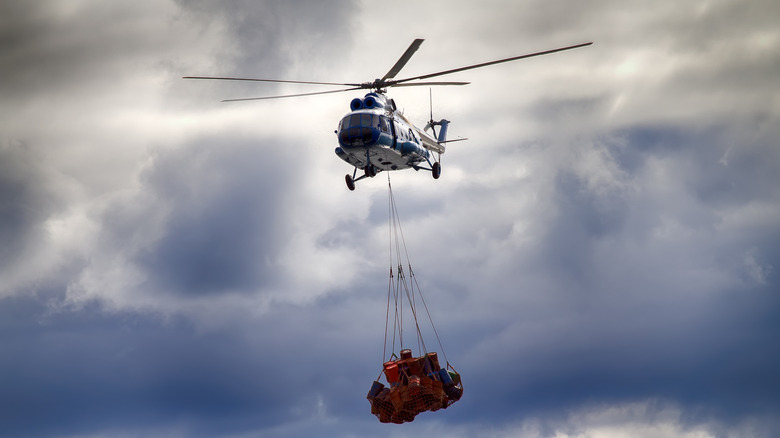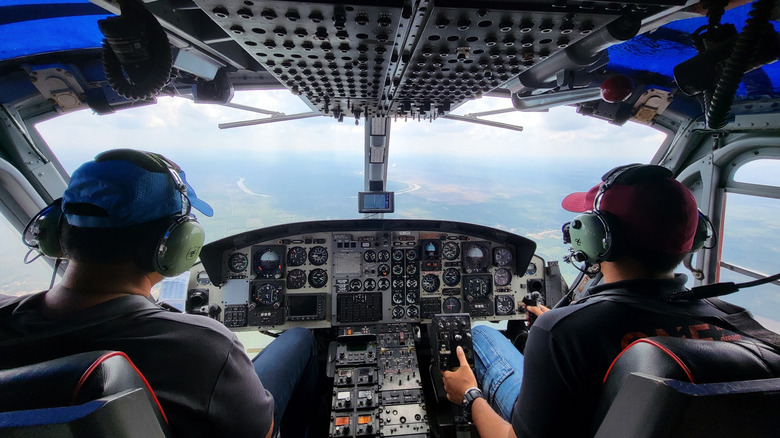Which Helicopter Has The Longest Range And How Far Can It Fly?
Helicopters come in a variety of models and designs intended for different purposes. Used by both civilians and the military, you'd be surprised at what some of these flying machines are capable of in terms of range. The record for the longest flight (without refueling) by a helicopter was set back in 1966 using a Hughes YOH-6A. Piloted by Robert Ferry, he flew from California to Florida, a distance of 2,213.1 miles.
Typically, in terms of non-military helicopters, the upper range is considerably less than the record, but still impressive. For example, the Airbus H225, with its maximum range configuration can travel around 610 nautical miles (701.9 miles). In terms of speed, you'd be shocked at how quickly the fastest civilian helicopters can travel.
As you might expect, the military has the capability to fly even farther without stopping to refuel. For instance, the Leonardo AW101 has a range of up to 810 nautical miles or around 932 miles, capable of cruising for upwards of 7 hours and 40 minutes. However, the CV-22 Osprey, which is a tiltrotor aircraft has a 500 nautical mile (575 miles) combat radius. This means that prepared for combat, and with an auxiliary fuel tank, the Osprey can cover over 1,100 miles.
Total flight range is dependent on several factors
A helicopter's ability to cover more nautical miles has to do with many variables, such as how much weight it's carrying. The number of passengers onboard, including the crew, and any additional equipment being transported, will have a direct effect on an aircraft's range. For example, the record flight, which was set in a Hughes YOH-6A, was an exceptionally lightweight aircraft that only carried the pilot, enabling it to achieve a more substantial flight distance.
Weather is also something that greatly influences performance, including range. Certain wind conditions can cause both the helicopter and pilot to have to work harder to counteract the forces during flight. An aircraft flying in humid conditions loses around 3 to 4% of its performance when compared to dryer conditions. Another consideration for range is the speed at which the aircraft is flying. You can bet that the fastest helicopter flights ever recorded didn't include significant distances.
Why are fixed-wing airplanes able to travel so much further than helicopters?
One of the reasons helicopters can't fly as far as fixed-wing airplanes is the fact that they must continuously generate lift via the rotors. Most helicopters also require an additional rotor on the tail to help stabilize them in the air. An airplane, on the other hand, achieves lift through air flowing over the wings, without any additional mechanical energy required beyond the main engines.
While a helicopter's ability to hover and land virtually anywhere is a great advantage, for long flights, a fixed-wing craft is far superior. Planes can travel comfortably at much greater speeds and have a much higher ceiling. At greater altitudes, the air is less dense, so fixed-wing aircraft can use less fuel, improving efficiency.
In addition, piloting a helicopter requires significant and continual input with complex controls. Managing power, precision maneuvering, and the fact that helicopters are less stable in the air than airplanes takes a toll on pilots. Essentially, fatigue may also be a factor when determining the range of these aircraft. Despite these challenges, a helicopter can fly across the Atlantic Ocean — and this one was the first, albeit with some caveats.


